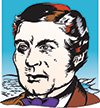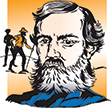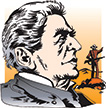
Folkstories, heros and villans of the Murray region
The Murray region...our heritage is built on explorers, bushrangers and legends
The quintessential Australian experience is along the Murray. You'll find amazing and interesting stories of pioneers, cattlemen and Aboriginal culture dating back thousands of years. There have been eight famous explorers connected to our region, wild stories of bushrangers including the famous Ned Kelly and some great Aussie legends including Banjo Paterson and the Man from Snowy River...and much more.

Explorers
 Sturt, Charles (1795-1869)
Sturt, Charles (1795-1869)
Often considered the finest of Australian explorers, Sturt made several notable and exciting journeys. In 1928-29 he explored the Macquarie, Bogan and Castlereagh rivers, and discovered the Darling. On the 1829-30 expedition he went by whale boat down the Murrumbidgee River and found and named the Murray, which he then explored to is mouth; he wrecked his health on the terrible return journey. In 1844-6 he travelled 3000 miles through inland Australia under very severe conditions. More about Charles Sturt.
 Eyre, Edward John (1815-1901)
Eyre, Edward John (1815-1901)
Eyre went to live in South Australia in 1838, and shortly afterwards started his journeys of exploration. His most notable feat was his crossing of the Nullarbor Plain in 1841. His companion, Baxter, was killed by two aboriginies who then deserted, leaving Eyre and Wylie, another aboriginal, to complete the hazardous journey reaching Albany, WA on 7th July. In 1841 Edward John Eyre was appointed Resident Magistrate and Protector of Aborigines on the Murray River. He established the post on his Moorundie property, which was 6 km downstream from the site near Blanchetown. Eyre was instrumental in maintaining peace between white settlers and Aborigines along the Murray River during the time of the overland stock route and the 'Rufus River massacre'. Read more about Moorundie.
 Mitchell, Sir Thomas Livingston (1792-1855)
Mitchell, Sir Thomas Livingston (1792-1855)
Mitchell was a notable explorer and Surveyor-General of New South Wales. His expeditions in 1831, 1835 and 1836 were aimed at completing the exploration of the inland rivers. He journeyed south from the Murray through the beautiful part of western Victoria which he called 'Australia Felix'. In 1845-46 he explored north from Bourke in an unsuccessful attempt to find a river flowing to the Gulf of Carpentaria.
 Strezelecki, Sir Paul Edmund de (1797-1873)
Strezelecki, Sir Paul Edmund de (1797-1873)
This Polish-born explorer and scientist spent 4 years in Australia exploring from northern New South Wales to Tasmania. Reaching Sydney in 1839, he discovered gold in the Bathurst district, but Governor Gipps asked him t keep it a secret. In 1840 he set out from Sydney to reach Port Phillip and, while crossing the Dividing Range, he named the highest peak Mount Kosciusko, after a famous Polish hero.
Hume, Hamilton (1797-1873)
The 1824 expedition was initiated by Sir Thomas Brisbane to find a way between Sydney and Bass Strait. Hume did discover other regions prior including the Lakes Bathurst, Goulburn and Yass Plains. In 1828-29 he was a member of Sturt's party in the exploration of the Castlereagh and Bogan Rivers. Hume acknowledged Sturt as his superior and was happy to accept a secondary role. Hume's ability to converse with the Aboriginies was an important skill. Read about the Hovell & Hume Expedition.
 Hovell, William (1786-1875)
Hovell, William (1786-1875)
A retired sea captain who had settled at Narellan, NSW, he accompanied Hume on a famous journey of exploration south to Port Phillip, sharing part of the cost. Hovell's part in the expedition has sometimes been belittled, and subsequently he and Hume remained on bad terms, but his share in the feat was important. Read about the Hovell & Hume Expedition.
Burke, Robert O'Hara (1821-61)
Wills, William John (1834-61)
In 1860, after much discussion, Burke was selected to lead an expedition northwards across Australia from Melbourne to the Gulf of Carpentaria.The expedition crossed the Murray River at Swan Hill. The expedition was well equipped by public and private money; but, mainly because of Burke's impatience and lack of bushcraft, it was a tragic failure. He died of exhaustion and starvation on the return journey.
Wills was second in command of the ill-fated Burke and Wills expedition across Australia in 1860-61. Wills was a man of very good character, but too modest for his sensible views on the expedition to prevail against the domineering Burke. Had Wills' advice been taken, he would probably have survived, but both he and Burke died of starvation, while trying to reach Adelaide.
Bushrangers
Ned Kelly (1855-1880)
Edward (Ned) Kelly was born at Beveridge, Victoria in June 1855. The family lived in a bush shack at Eleven Mile Creek in northern Victoria. Known as a ‘flash’ in his early teens, Ned was recognised as an excellent horseman, and could hold his own in a pub brawl.
After a few clashes with the law, Ned was first jailed in 1870 for 3 months with hard labour when 15 years old, for assault and indecent behaviour.
During January 1879 the Kelly's were seen in the Rutherglen-Corowa region. They crossed the Murray River into New South Wales to escape the Victorian Police. New South Wales was considered a safe haven. Ned knew the river crossings well as he had previously worked at Fairfield Vineyard, danced at Forty’s Pub in Wahgunyah, and drank in Corowa.
On 27 June 1880, Ned and Dan, Steve Hart and Joe Byrne captured the town of Glenrowan. During the shootout Ned received five serious bullet wounds, one had passed through his foot from the toe to heel; 25 minor shotgun blasts on his hands and legs, and his face, head and eyes and groin were extensively bruised. Kelly was hung at the Old Melbourne Gaol on 11 November 1880. Read more about Ned Kelly.
Captain Moonlite (1842-1880)
One of the legendary visitors to the Overland Corner Hotel (SA) was the famous Captain Moonlight, a daring bushranger of Irish origin, whose real name was Andrew George Scott, alias ‘Preacher’ Scott. After a stint in prison, he graduated to bushranging. During 1879 when he was on the run from the New South Wales and Victorian Police he used the Overland Corner Hotel as a watering hole. While drinking, and still on horse back, he demanded that both front and back doors of the hotel be left open. He was eventually captured at Wagga Wagga and hanged on 20 January 1880 at Darlinghurst Gaol, Sydney.
Mad Dog Morgan (1830-1865)
One of the more infamous characters from the history of the Culcairn and the surrounding districts was Daniel Morgan, one of the most unpleasant bushrangers of Australia's past.
Born in Sydney in 1833 of poor irish parents, he left and join the gold rush in 1853. However on the way he turned to a life of petty crime, from which he graduated to robbery, which earned him a 12 year sentence of hard labour. Morgan was an excellent bushman, and this enabled him to evade the police. His hideout 6 miles north of Walla Walla provided an 180° view of the surrounding district (now a lookout).
On 8 April 1865, Dan Morgan, held up the McPherson family at Peechalba Station, Victoria. The following morning Dan found himself surrounded by police. He was shot in the back by station employee John Wendlan. He was buried at Wangaratta Cemetery. Read more about Mad Dog Morgan.
Legends
Jack Riley (1841-1914) Man from Snowy River
Jack was the legendary horseman who migrated from Ireland to Australia as a 13-year-old in 1851. Jack worked as a tailor near Omeo but found his true passion as a stockman, he worked for the Pierce family of Greg Greg, near Corryong.
Jack lived in isolation in a hut high up in the hills at Tom Groggin. He loved the Snowy Mountain Country, a good yarn and enjoyed a social drink or two. Jack was also a good mate of the late Walter Mitchell of Towong Station, who introduced Jack Riley to Banjo Paterson when the pair was on a camping trip. They trekked the Kosciusko Ranges and the Snowys, shared many campfires and yarns too. Jack was the Man from Snowy River who provided an inspirational journey and material for Banjo to write his now famous poem. Reality or myth
Banjo Paterson (1864-1941)
Waltzing Matilda was written by A.B. ('Banjo') Paterson in 1896, at Winton, Queensland. One day while visiting Mr Robert McPherson a large sheep station owner they saw an old swagman trying to catch a sheep for his tuckerbox. McPherson stopped the buggy, exclaiming, 'He's after a jumbuck!' And jumping down he chased the swaggie away. (Jumbuck was Aboriginal phrase for sheep).
This caught Paterson's imagination and he softly spoke the lines of 'Waltzing Matilda'. Accompanying Paterson was Miss Christina McPherson who was intrigued with the words and told the poet that she had heard a brass band playing a tune that she though would suit them. When they reached Miss Riley's home Paterson and Miss McPherson sat down at the harmonium and adapted the tune to the words. The tune is an old Rochester (Kent) marching air of the Marlborough Wars.
Incidentally, as a baby, Christina McPherson (1864-1936), figured in the capture of Mad Dan Morgan. When that bushranger held up the McPherson homestead at Peechelba, Victoria (30km south-west of Corowa), he ordered food to be brought to him. Then he 'requested' Mrs McPherson to play the harmonium to him while he ate. As the baby, Christina, kept crying in the next room, he angrily told a nursemaid Alice Keenan to 'go out and keep that brat quiet'. She managed to escape and inform Mr Rutherford, the co-owner of the property and the police.
R.M. Williams (1908-2003)
Reginald Murray (R.M.) Williams was a Jack of all trades. At various times he has been a bushman, camel boy, bricklayer, businessman, tea grower in New Guinea, builder, horse breeder, grazier, explorer, miner, tycoon, raconteur, well sinker, stockman, avid reader, author, drover and the list could go on.
His childhood years were difficult but he grew up quickly and from an early age learnt to handle horses on his father's property at Belalie. He left school at the age of 14. After leaving home to see the world he took on jobs wherever they were available. One of his first jobs was learning to burn lime for the construction of a church in Underbool, in the Victorian mallee. On the Western Australian goldfields he helped establish a mission for Aborigines. He learnt much from his association with them. In particular their bushcraft, cutting mulga, burning limestone, how to find water and track animals. Later in life he said that 'The mastery of these Aborigines over their environment has been the inspiration of my life'.
Tell your friends you found this at murrayriver.com.au!
Copyright Discover Murray 2025. This site or any portion of this site must not be reproduced, duplicated, copied, sold, resold, or otherwise exploited for any commercial purpose that is not expressly permitted by DISCOVER MURRAY.






 Lee Kernaghan Boys From The Bush The Concert
Lee Kernaghan Boys From The Bush The Concert Kevin Bloody Wilson Aussie Icon Tour with special guest Jenny Talia
Kevin Bloody Wilson Aussie Icon Tour with special guest Jenny Talia The Australian Beach Boys Show
The Australian Beach Boys Show Little By Little
Little By Little Amy Shark The Solo Acoustic "Songs & Stories" Tour
Amy Shark The Solo Acoustic "Songs & Stories" Tour